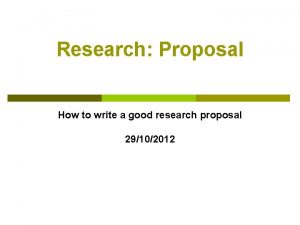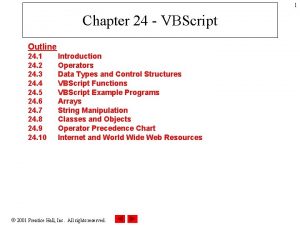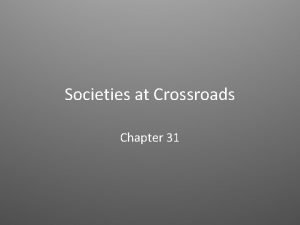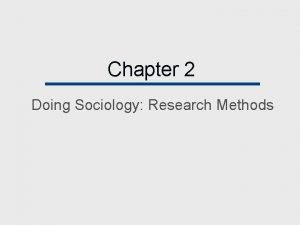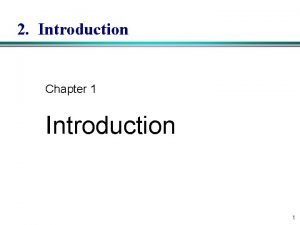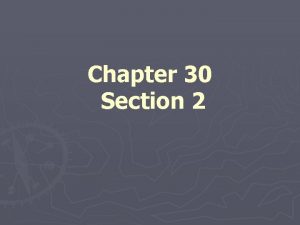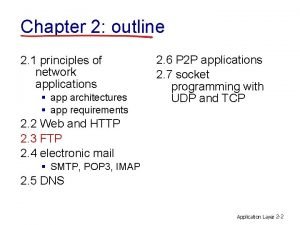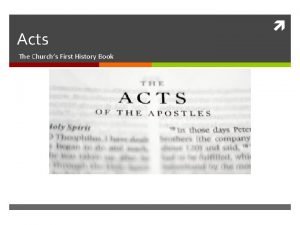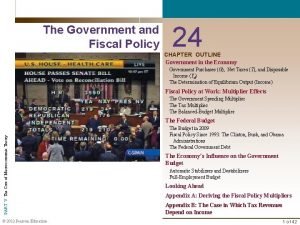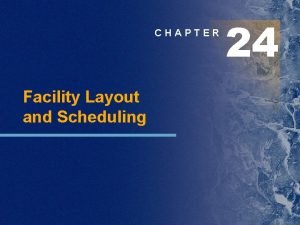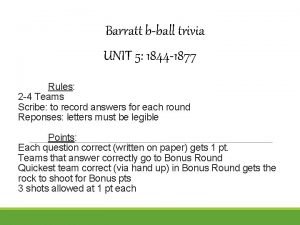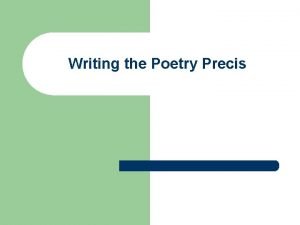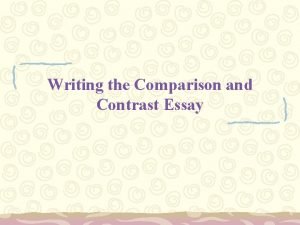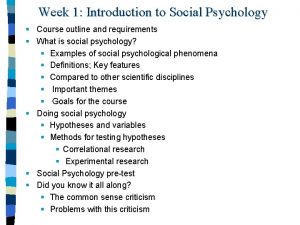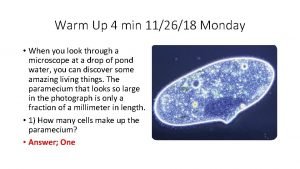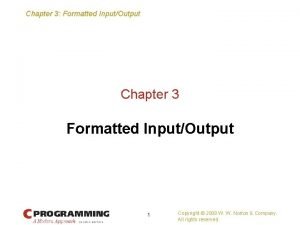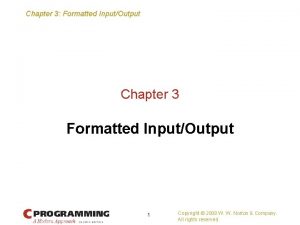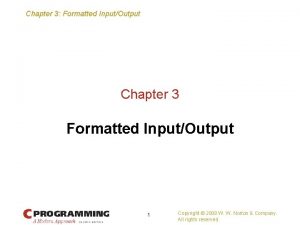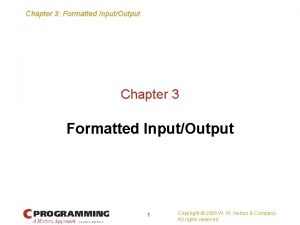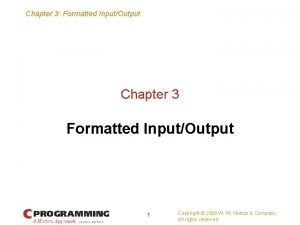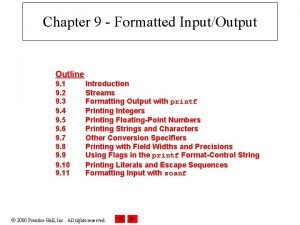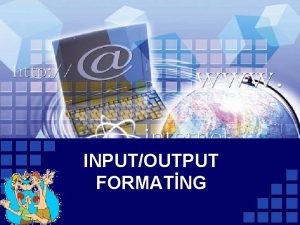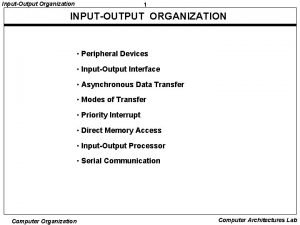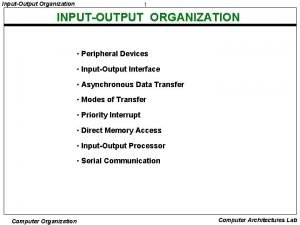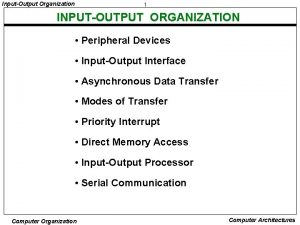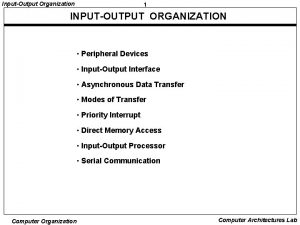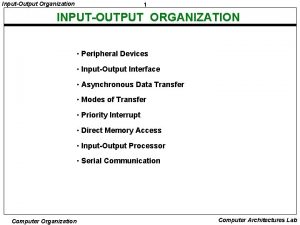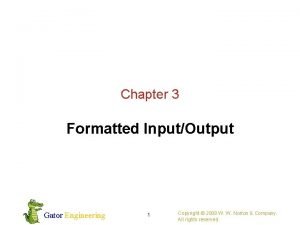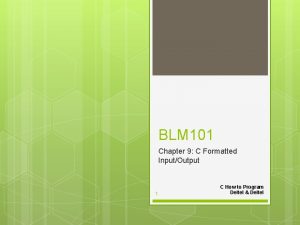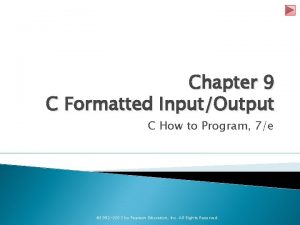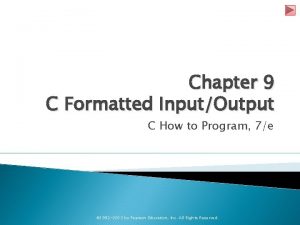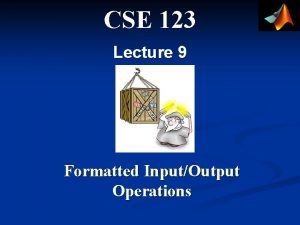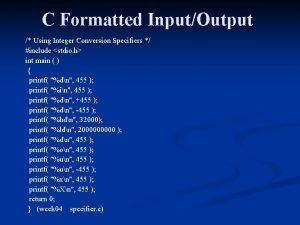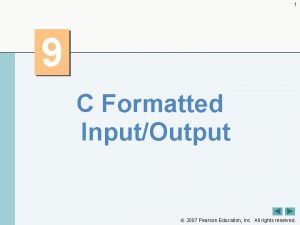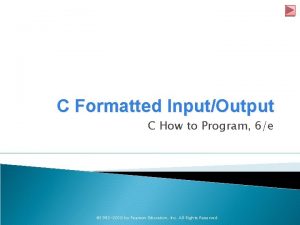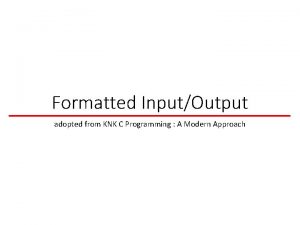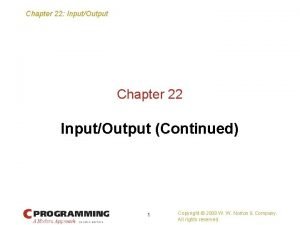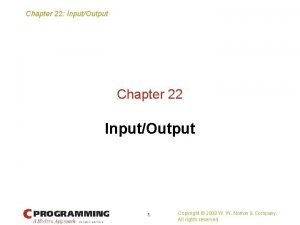1 Chapter 9 Formatted InputOutput Outline 9 1




























- Slides: 28

1 Chapter 9 - Formatted Input/Output Outline 9. 1 9. 2 9. 3 9. 4 9. 5 9. 6 9. 7 9. 8 9. 9 9. 10 9. 11 Introduction Streams Formatting Output with printf Printing Integers Printing Floating-Point Numbers Printing Strings and Characters Other Conversion Specifiers Printing with Field Widths and Precisions Using Flags in the printf Format-Control String Printing Literals and Escape Sequences Formatting Input with scanf 2000 Prentice Hall, Inc. All rights reserved.

2 9. 1 Introduction • In this chapter – Presentation of results – scanf and printf – Streams (input and output) • gets, puts, getchar, putchar (in <stdio. h>) 2000 Prentice Hall, Inc. All rights reserved.

3 9. 2 Streams • Streams – Sequences of characters organized into lines • Each line consists of zero or more characters and ends with newline character • ANSI C must support lines of at least 254 characters – Performs all input and output – Can often be redirected • • Standard input – keyboard Standard output – screen Standard error – screen More Chapter 11 2000 Prentice Hall, Inc. All rights reserved.

4 9. 3 Formatting Output with printf • printf – Precise output formatting • Conversion specifications: flags, field widths, precisions, etc. – Can perform rounding, aligning columns, right/left justification, inserting literal characters, exponential format, hexadecimal format, and fixed width and precision • Format – printf( format-control-string, other-arguments ); – Format control string: describes output format – Other-arguments: correspond to each conversion specification in format-control-string • Each specification begins with a percent sign(%), ends with conversion specifier 2000 Prentice Hall, Inc. All rights reserved.

5 9. 4 Printing Integers • Integer – Whole number (no decimal point): 25, 0, -9 – Positive, negative, or zero – Only minus sign prints by default (later we shall change this) 2000 Prentice Hall, Inc. All rights reserved.

1 2 3 4 5 6 7 8 9 10 11 12 13 14 15 16 17 18 19 20 /* Fig 9. 2: fig 09_02. c */ Outline /* Using the integer conversion specifiers */ #include <stdio. h> int main() { printf( "%dn", 455 ); printf( "%in", 455 ); /* i same as d in printf */ printf( "%dn", +455 ); printf( "%dn", -455 ); printf( "%hdn", 32000 ); printf( "%ldn", 200000 ); printf( "%on", 455 ); printf( "%un", -455 ); printf( "%xn", 455 ); printf( "%Xn", 455 ); return 0; } 455 455 -455 3200000 707 455 65081 1 c 7 1 C 7 2000 Prentice Hall, Inc. All rights reserved. 1. Print Program Output 6

7 9. 5 Printing Floating-Point Numbers • Floating Point Numbers – Have a decimal point (33. 5) – Exponential notation (computer's version of scientific notation) • 150. 3 is 1. 503 x 10² in scientific • 150. 3 is 1. 503 E+02 in exponential (E stands for exponent) • use e or E – f – print floating point with at least one digit to left of decimal – g (or G) - prints in f or e with no trailing zeros (1. 2300 becomes 1. 23) • Use exponential if exponent less than -4, or greater than or equal to precision (6 digits by default) 2000 Prentice Hall, Inc. All rights reserved.

1 2 3 4 5 6 7 8 9 10 11 12 13 14 15 16 17 18 /* Fig 9. 4: fig 09_04. c */ /* Printing floating-point numbers with floating-point conversion specifiers */ #include <stdio. h> Outline 1. Print main() { printf( "%en", 1234567. 89 ); printf( "%en", +1234567. 89 ); printf( "%en", -1234567. 89 ); printf( "%En", 1234567. 89 ); printf( "%fn", 1234567. 89 ); printf( "%gn", 1234567. 89 ); printf( "%Gn", 1234567. 89 ); return 0; } 1. 234568 e+006 -1. 234568 e+006 1. 234568 E+006 1234567. 890000 1. 23457 e+006 1. 23457 E+006 2000 Prentice Hall, Inc. All rights reserved. Program Output 8

9 9. 6 Printing Strings and Characters • c – Prints char argument – Cannot be used to print the first character of a string • s – Requires a pointer to char as an argument – Prints characters until NULL ('�') encountered – Cannot print a char argument • Remember – Single quotes for character constants ('z') – Double quotes for strings "z" (which actually contains two characters, 'z' and '�') 2000 Prentice Hall, Inc. All rights reserved.

1 /* Fig 9. 5: fig 09_05 c */ 2 3 4 5 6 /* Printing strings and characters */ #include <stdio. h> 7 character = 'A'; 8 9 char string[] = "This is a string"; const char *string. Ptr = "This is also a string"; int main() { Outline 1. Initialize variables 2. Print 10 11 printf( "%cn", character ); 12 printf( "%sn", "This is a string" ); 13 printf( "%sn", string ); 14 printf( "%sn", string. Ptr ); 15 16 return 0; 17 } A This is a string This is also a string 2000 Prentice Hall, Inc. All rights reserved. Program Output 10

11 9. 7 Other Conversion Specifiers • p – Displays pointer value (address) • n – Stores number of characters already output by current printf statement – Takes a pointer to an integer as an argument – Nothing printed by a %n specification – Every printf call returns a value • Number of characters output • Negative number if error occurs • % – Prints a percent sign – %% 2000 Prentice Hall, Inc. All rights reserved.

1 /* Fig 9. 7: fig 09_07. c */ 2 /* Using the p, n, and % conversion specifiers */ 3 #include <stdio. h> 4 5 int main() 6 { 7 int *ptr; 8 int x = 12345, y; 9 10 ptr = &x; 11 printf( "The value of ptr is %pn", ptr ); 12 printf( "The address of x is %pnn", &x ); 13 14 printf( "Total characters printed on this line is: %n", &y ); 15 printf( " %dnn", y ); 16 17 y = printf( "This line has 28 charactersn" ); 18 printf( "%d characters were printednn", y ); 19 20 printf( "Printing a %% in a format control stringn" ); 21 22 return 0; 23 } The value of ptr is 0065 FDF 0 The address of x is 0065 FDF 0 Total characters printed on this line is: 41 This line has 28 characters were printed Printing a % in a format control string 2000 Prentice Hall, Inc. All rights reserved. Outline 1. Initialize variables 2. Print Program Output 12

9. 8 Printing with Field Widths and Precisions • Field width – Size of field in which data is printed – If width larger than data, default right justified • If field width too small, increases to fit data • Minus sign uses one character position in field – Integer width inserted between % and conversion specifier – %4 d – field width of 4 2000 Prentice Hall, Inc. All rights reserved. 13

9. 8 Printing with Field Widths and Precisions • Precision – Meaning varies depending on data type – Integers (default 1) • Minimum number of digits to print – If data too small, prefixed with zeros – Floating point • Number of digits to appear after decimal (e and f) – For g – maximum number of significant digits – Strings • Maximum number of characters to be written from string – Format • Use a dot (. ) then precision number after % %. 3 f 2000 Prentice Hall, Inc. All rights reserved. 14

9. 8 Printing with Field Widths and Precisions • Field width and precision – Can both be specified • %width. precision %5. 3 f – – Negative field width – left justified Positive field width – right justified Precision must be positive Can use integer expressions to determine field width and precision values • Place an asterisk (*) in place of the field width or precision – Matched to an int argument in argument list • Example: printf( "%*. *f", 7, 2, 98. 736 ); 2000 Prentice Hall, Inc. All rights reserved. 15

1 2 3 4 5 6 7 8 9 10 11 12 13 14 15 16 17 18 19 20 /* Fig 9. 9: fig 09_09. c */ /* Using precision while printing integers, floating-point numbers, and strings */ #include <stdio. h> int main() { int i = 873; double f = 123. 94536; char s[] = "Happy Birthday"; Outline 1. Initialize variables 2. Print printf( "Using precision for integersn" ); printf( "t%. 4 dnt%. 9 dnn", i, i ); printf( "Using precision for floating-point numbersn" ); printf( "t%. 3 fnt%. 3 ent%. 3 gnn", f, f, f ); printf( "Using precision for stringsn" ); printf( "t%. 11 sn", s ); return 0; } Using precision for integers 0873 000000873 Using precision for floating-point numbers 123. 945 1. 239 e+02 124 Using precision for strings Happy Birth 2000 Prentice Hall, Inc. All rights reserved. Program Output 16

9. 9 Using Flags in the printf Format-Control String • Flags – Supplement formatting capabilities – Place flag immediately to the right of percent sign – Several flags may be combined 2000 Prentice Hall, Inc. All rights reserved. 17

1 /* Fig 9. 11: fig 09_11. c */ 2 /* Right justifying and left justifying values */ 3 #include <stdio. h> 4 Outline 1. Print 5 int main() 6 { 7 printf( "%10 s%10 d%10 c%10 fnn", "hello", 7, 'a', 1. 23 ); 8 printf( "%-10 s%-10 d%-10 c%-10 fn", "hello", 7, 'a', 1. 23 ); 9 return 0; 10 } hello 7 a 1. 230000 hello 7 a 1. 230000 2000 Prentice Hall, Inc. All rights reserved. Program Output 18

1 2 3 4 5 6 7 8 9 10 11 12 13 14 15 16 17 18 /* Fig 9. 14: fig 09_14. c */ /* Using the # flag with conversion specifiers o, x, X and any floating-point specifier */ #include <stdio. h> int main() { int c = 1427; double p = 1427. 0; printf( "%#on", c ); printf( "%#xn", c ); printf( "%#Xn", c ); printf( "n%gn", p ); printf( "%#gn", p ); Outline 1. Initialize variables 2. Print return 0; } 02623 0 x 593 0 X 593 1427. 00 2000 Prentice Hall, Inc. All rights reserved. Program Output 19

9. 10 Printing Literals and Escape Sequences • Printing Literals – Most characters can be printed – Certain "problem" characters, such as the quotation mark " – Must be represented by escape sequences • Represented by a backslash followed by an escape character 2000 Prentice Hall, Inc. All rights reserved. 20

9. 10 Printing Literals and Escape Sequences • Table of all escape sequences 2000 Prentice Hall, Inc. All rights reserved. 21

22 9. 11 Formatting Input with Scanf • scanf – Input formatting – Capabilities • Input all types of data • Input specific characters • Skip specific characters • Format – scanf(format-control-string, other-arguments); – Format-control-string • Describes formats of inputs – Other-arguments • Pointers to variables where input will be stored – Can include field widths to read a specific number of characters from the stream 2000 Prentice Hall, Inc. All rights reserved.

23 9. 11 Formatting Input with Scanf 2000 Prentice Hall, Inc. All rights reserved.

24 9. 11 Formatting Input with Scanf • Table continued from previous slide 2000 Prentice Hall, Inc. All rights reserved.

25 9. 11 Formatting Input with Scanf • Scan sets – Set of characters enclosed in square brackets [] • Preceded by % sign – Scans input stream, looking only for characters in scan set • Whenever a match occurs, stores character in specified array • Stops scanning once a character not in the scan set is found – Inverted scan sets • Use a caret ^: [^aeiou] • Causes characters not in the scan set to be stored • Skipping characters – Include character to skip in format control – Or, use * (assignment suppression character) • Skips any type of character without storing it 2000 Prentice Hall, Inc. All rights reserved.

1 2 3 4 5 6 7 8 9 10 11 12 13 14 15 16 17 /* Fig 9. 20: fig 09_20. c */ /* Reading characters and strings */ #include <stdio. h> int main() { char x, y[ 9 ]; printf( "Enter a string: " ); scanf( "%c%s", &x, y ); Outline 1. Initialize variables 2. Input 3. Print printf( "The input was: n" ); printf( "the character "%c" ", x ); printf( "and the string "%s"n", y ); return 0; } Enter a string: Sunday The input was: the character "S" and the string "unday" 2000 Prentice Hall, Inc. All rights reserved. Program Output 26

1 2 3 4 5 6 7 8 9 10 11 12 13 14 /* Fig 9. 22: fig 09_22. c */ /* Using an inverted scan set */ #include <stdio. h> int main() { char z[ 9 ] = { '�' }; printf( "Enter a string: " ); scanf( "%[^aeiou]", z ); printf( "The input was "%s"n", z ); Outline 1. Initialize variable 2. Input 3. Print return 0; } Enter a string: String The input was "Str" 2000 Prentice Hall, Inc. All rights reserved. Program Output 27

1 2 3 4 5 6 7 8 9 10 11 12 13 14 15 16 17 18 19 /* Fig 9. 24: fig 09_24. c */ /* Reading and discarding characters from the input stream */ #include <stdio. h> int main() { int month 1, day 1, year 1, month 2, day 2, year 2; printf( "Enter a date in the form mm-dd-yyyy: " ); scanf( "%d%*c%d", &month 1, &day 1, &year 1 ); printf( "month = %d day = %d year = %dnn", month 1, day 1, year 1 ); printf( "Enter a date in the form mm/dd/yyyy: " ); scanf( "%d%*c%d", &month 2, &day 2, &year 2 ); printf( "month = %d day = %d year = %dn", month 2, day 2, year 2 ); Outline 1. Initialize variables 2. Input 3. Print return 0; } Enter a date in the form mm-dd-yyyy: 11 -18 -2000 month = 11 day = 18 year = 2000 Enter a date in the form mm/dd/yyyy: 11/18/2000 month = 11 day = 18 year = 2000 Prentice Hall, Inc. All rights reserved. Program Output 28
 Inputoutput devices
Inputoutput devices Apa titles
Apa titles Snmp osi model
Snmp osi model Sandwich paragraph example
Sandwich paragraph example Chapter 7 learning goals outline sociology
Chapter 7 learning goals outline sociology Romans outline by chapter
Romans outline by chapter Research proposal elements
Research proposal elements Give me liberty chapter 27
Give me liberty chapter 27 Methodology chapter outline
Methodology chapter outline Chapter 38 a world without borders outline
Chapter 38 a world without borders outline Vbscript
Vbscript The hunger games chapter 24 questions and answers
The hunger games chapter 24 questions and answers Chapter 31 societies at crossroads outline
Chapter 31 societies at crossroads outline General hero
General hero Advantage and disadvantage of observation method
Advantage and disadvantage of observation method Chapter 1 outline
Chapter 1 outline Chapter 1 outline
Chapter 1 outline Chapter 30
Chapter 30 Chapter 2 outline
Chapter 2 outline Outline of the book of acts by chapter
Outline of the book of acts by chapter 24 chapter outline
24 chapter outline 24 chapter outline
24 chapter outline Apush chapter 16 conquering a continent outline
Apush chapter 16 conquering a continent outline Rhetorical precis template
Rhetorical precis template Leq paragraph structure
Leq paragraph structure Block method outline
Block method outline Social psychology course outline
Social psychology course outline Lesson outline lesson 3 describing circuits answers
Lesson outline lesson 3 describing circuits answers Brainpop protists
Brainpop protists






